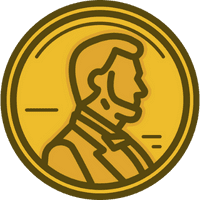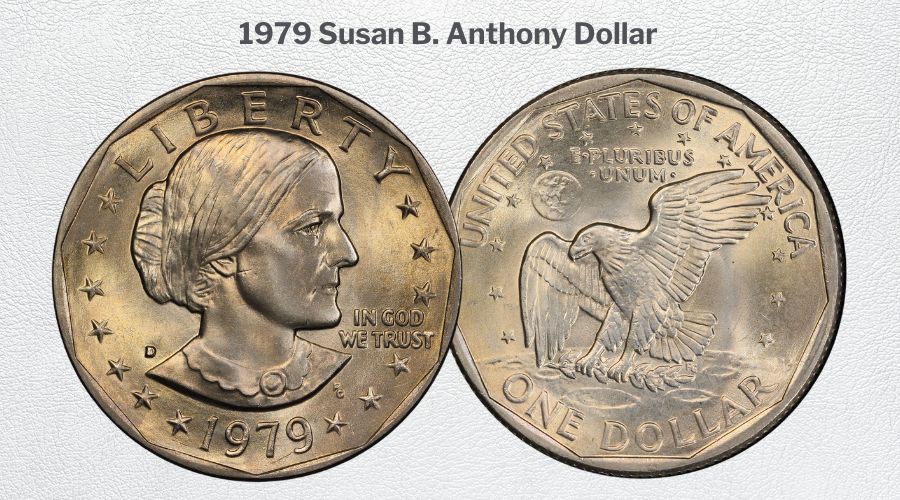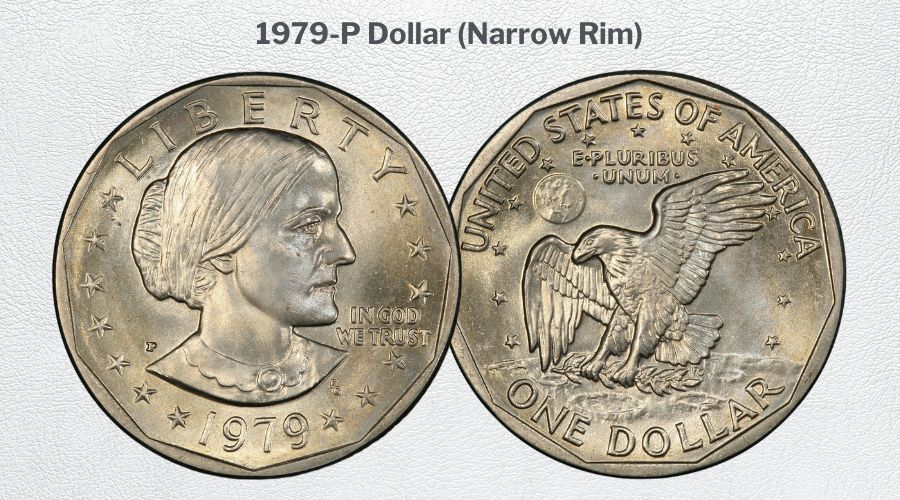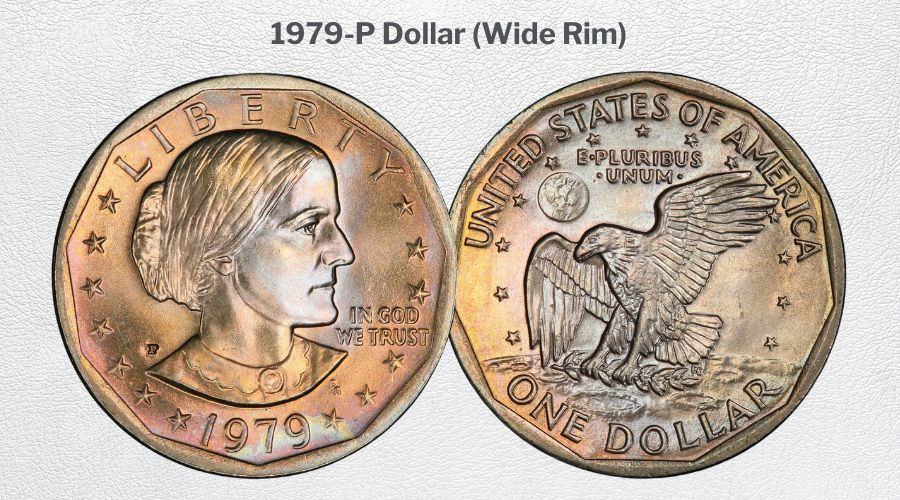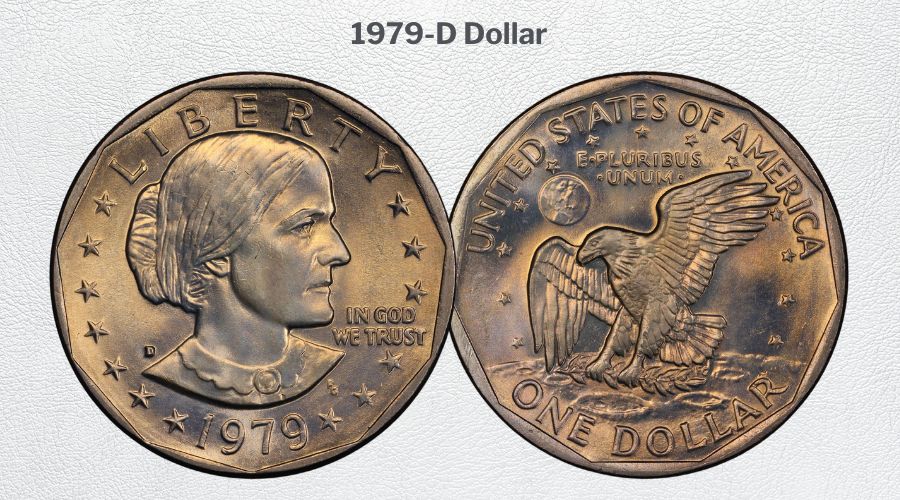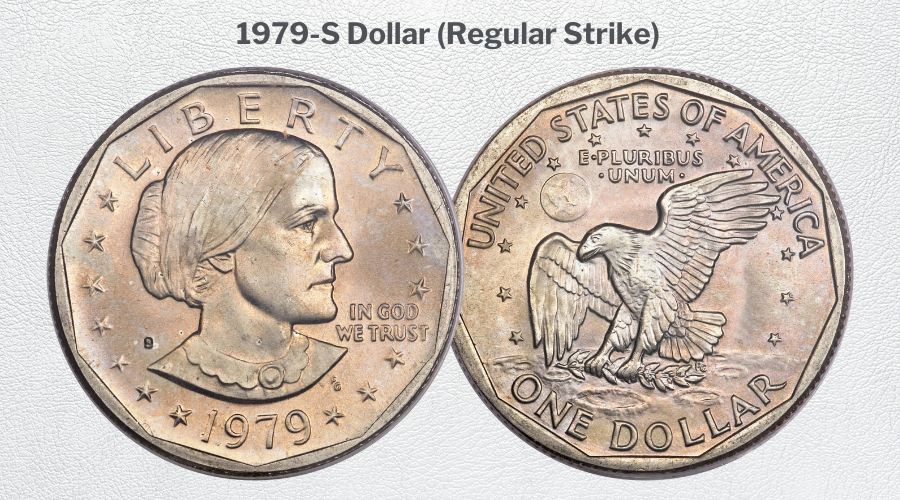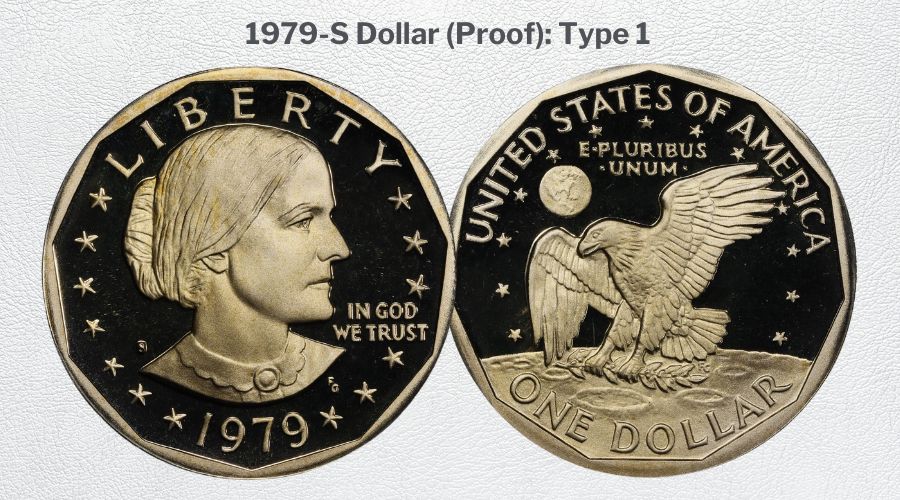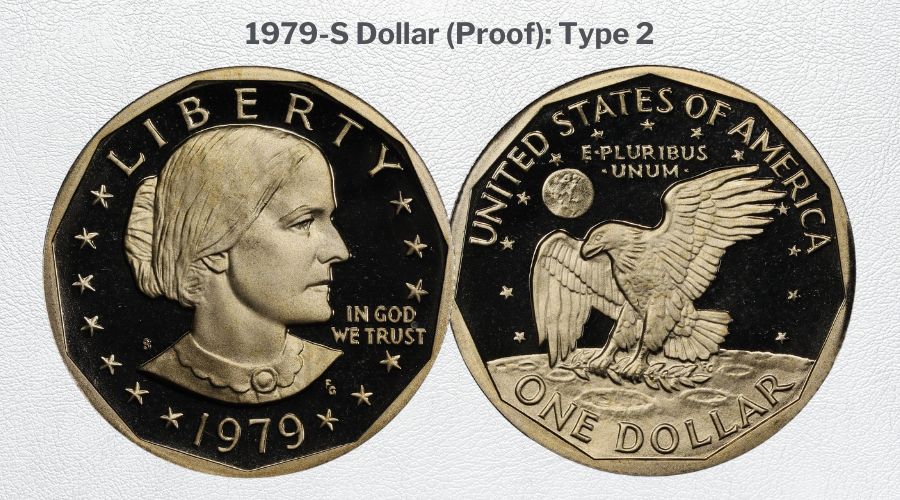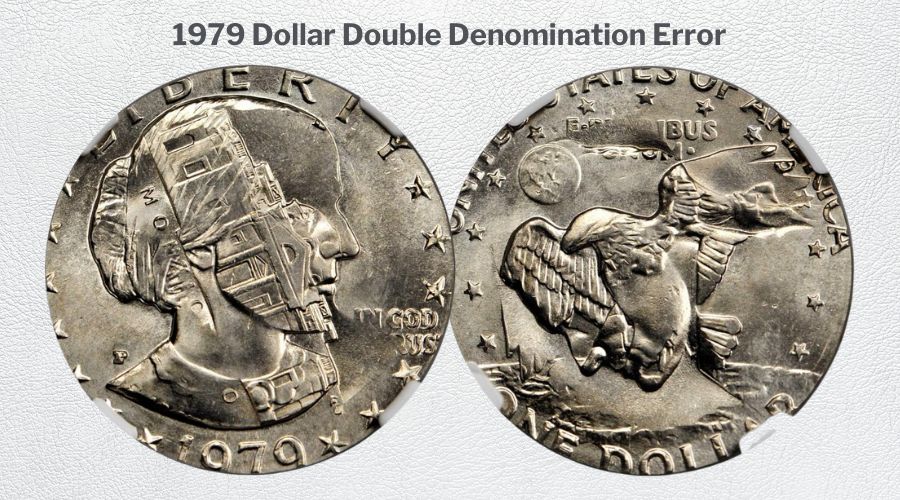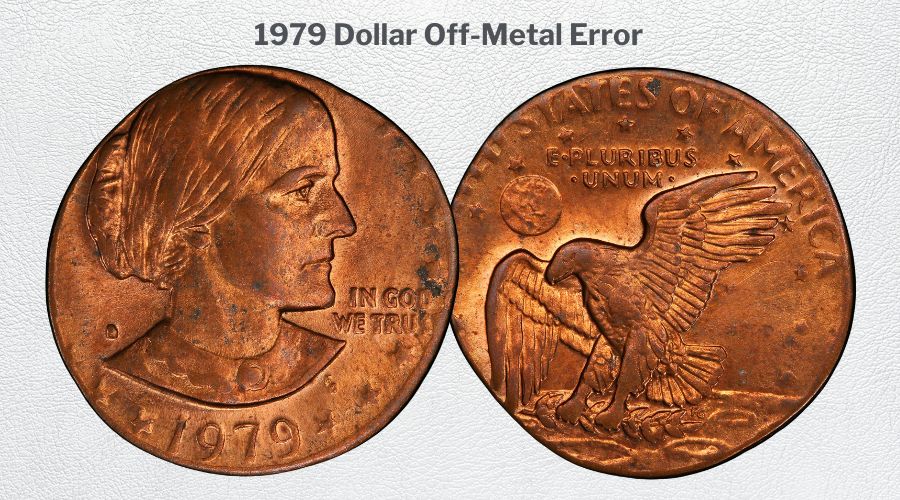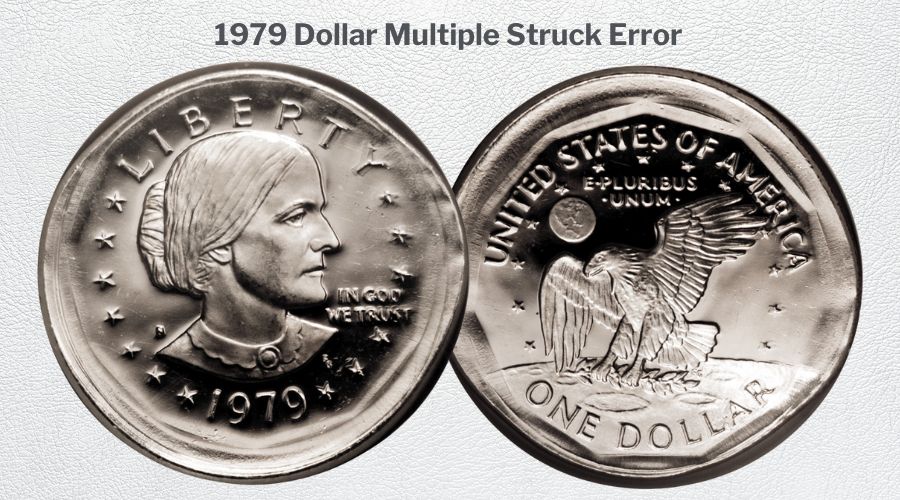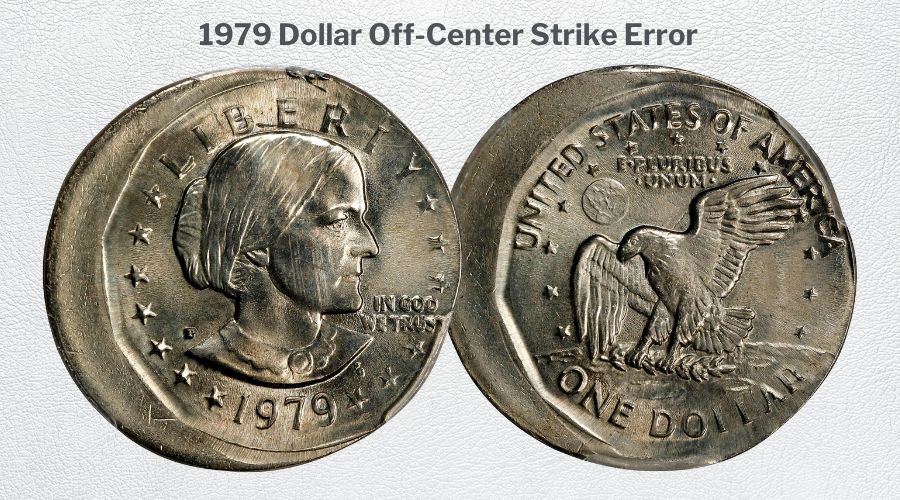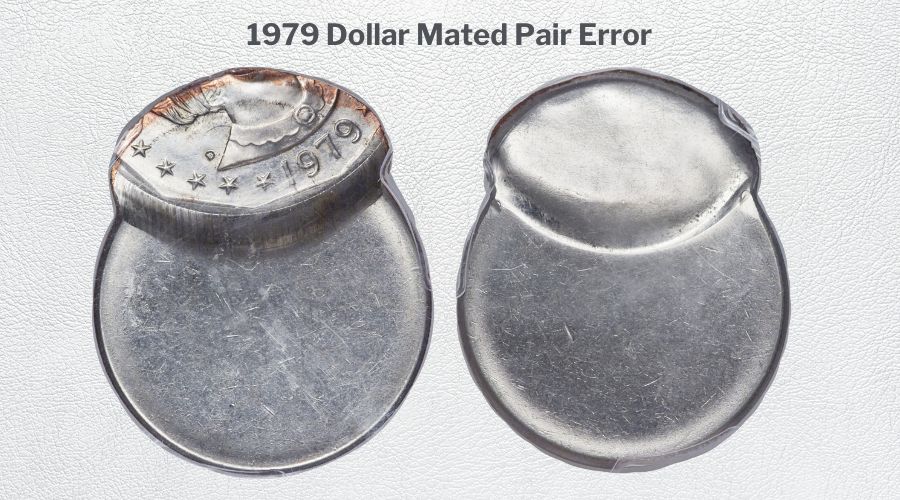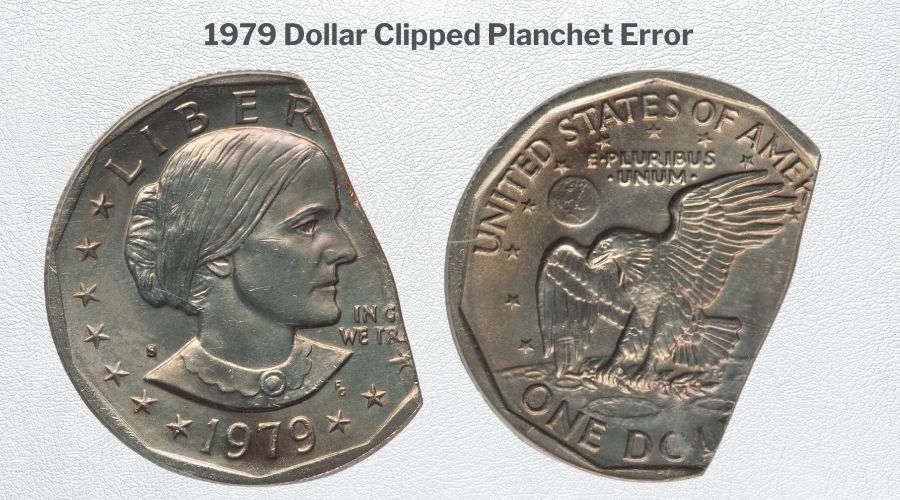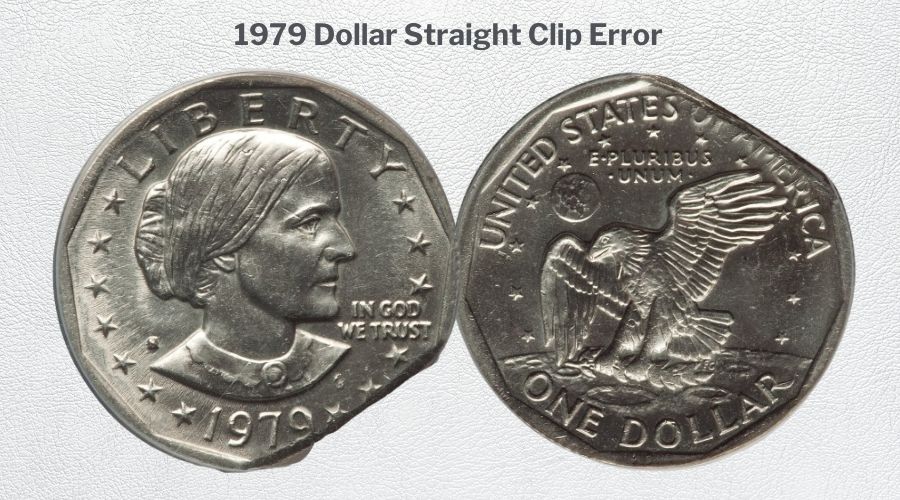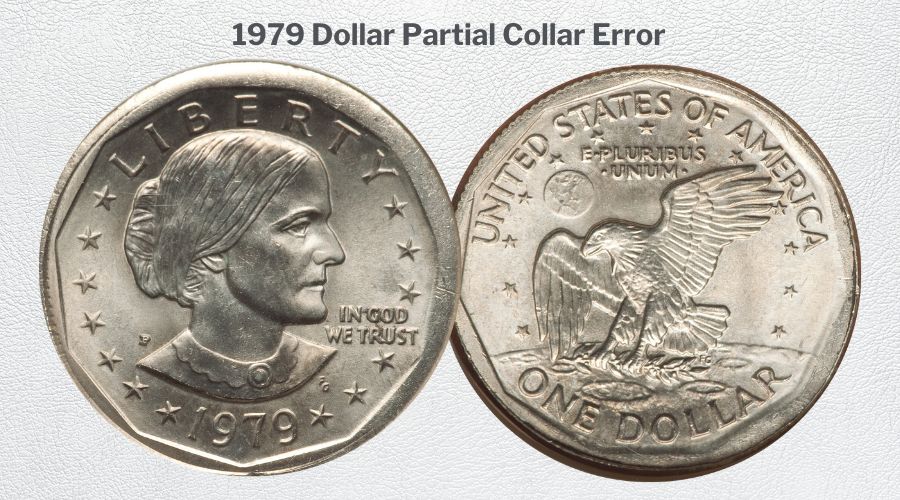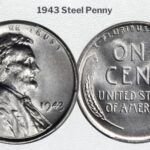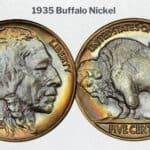The 1979 Susan B. Anthony (SBA) dollar coin is worth $1 in circulated conditions. Mint State uncirculated versions are at least $1 but can rise to $10,000 in their highest grades. Proof coins on the other hand are much cheaper, worth $1 – $175.
Overall, the highest auction price goes to a 1979-P SBA Dollar coin with an Overstruck mint error, sold for $15,275 in 2014.
Apart from its value, the coin is known for being the first coin that ever featured the portrait of a real woman, Susan B. Anthony, an American women’s rights activist notable for her role in the women’s suffrage movement.
Read on to dive into the intriguing history of this coin and why you should invest in it. Get to learn the value of each variety and the unique errors that will earn you a small fortune.
1979 Susan B. Anthony Dollar Coin Details
- Category/Series: Susan B. Anthony Dollars (1979 – 1981, 1999)
- Mint: Philadelphia, Denver, San Francisco
- Mintage: 761,490,919
- Designer: Frank Gasparro
- Composition: 75% copper, 25% nickel over a pure copper center (copper-nickel clad)
- Weight: 8.10 grams
- Diameter: 26.50 millimeters
- Edge: Reeded
Susan B. Anthony (SBA) dollar coins were issued between 1979 and 1981, and then revived for one year in 1999.
It was the first U.S. coin to ever feature a real woman. This idea was conceptualized to address the lack of diversity in faces and figures that were portrayed in U.S. Coins.
By 1978, the Legislature passed Public Law 95-447 to add Susan B. Anthony (1820 – 1906) to their new dollar coin, a famous American women’s rights activist who pioneered the women’s suffrage movement in the U.S. during the 1800s.
1979 SBA Dollar coins are the first year of issue in the series.
Coin Size and Composition
The coin was designed with a smaller diameter (26.50 mm) instead of the standard 38.1 mm. The Mint wanted to reduce the size to address its weight which had prevented mass adoption in the past.
However, the small size made it hard for consumers to differentiate the dollars from quarter dollars. This is because the two coins were almost similar in size, were made of the same clad composition, and had similar looks.
Susan B. Anthony dollars became unpopular quickly and this led to their termination in 1981 after just three years in circulation.
Reprieved in 1999
The U.S. Postal Service requested another release of the SBA dollar coins in 1999 to help with their services like the vending machines.
The new SBA dollars were only issued in 1999 and replaced in 2000 by the Sacagawea “Golden” Dollar (2000 – Date).
1979 Dollar Coin Design and Minting
The obverse features Susan B. Anthony facing to the right with six stars on the right and seven stars on the left.
IN GOD WE TRUST is on the right amidst the six stars, LIBERTY is on the top center, and the date is on the bottom center. A mintmark (P, S, or D) is located on the lower left above Susan’s shoulder.
The reverse shows an eagle landing on the moon holding a branch. Earth is on the top background with UNITED STATES OF AMERICA on top center and E PLURIBUS UNUM underneath. ONE DOLLAR is inscribed at the bottom.
Both sides have an eleven-sided inner border.
Below is the mintage number from each mint.
| Mint | Mint Mark | Total Mintage |
| Philadelphia | P | 360,222,000 |
| Denver | D | 288,015,744 |
| San Francisco (Regular Strike) | S | 109,576,000 |
| San Francisco (Proof) | S | 3,677,175 |
| Total Mintage | 761,490,919 |
What Makes the 1979 Dollar Coin Valuable?
The main factors contributing to its value include:
1. Coin Condition
Collectors and numismatists only value proof and uncirculated examples, especially those in the highest grades.
If your coin is worn, then it is a circulation coin worth $1. If it has no evidence of wear (uncirculated) then it is $3 – $10,000.
However, if it lies between (AU50 – AU58), then it can be worth $1 – $17.
For a more comprehensive understanding of coin grades, please read this complete guide on what coin grades mean.
2. Notable Varieties
There are only two varieties that are priced higher than the regular SBA dollars:
- 1979-P Wide Rim: Has a wider rim than the regular 1979-P (Narrow Rim) SBA dollar coin. It adds a unique character to the coin making it more sought after and higher in market value.
- 1979-S Proof: Type 2 (Clear “S” Mintmark): Type 1 and Type 2 Proof coins were made in San Francisco. Type 1 has a filled “S” that is less appealing than the clear “S” in Type 2, which is more attractive, and hence highly valued.
Note: “1979 Susan B Anthony blob mint mark” coins listed online refer to the Type 1 variety of the Proof coins. The “blob” refers to the filled “S” mint mark that is more rounded and filled in. It is the most common, less valuable of the two varieties.
3. Rare Errors
The rarest errors more valuable than common SBA dollars are:
- Double Denomination
- Wrong Planchet
- Multiple Strikes
1979 Susan B. Anthony Dollar Value
All three mints produced circulation coins giving us the 1979-P (Narrow & Wide Rim varieties), 1979-D, and 1979-S.
San Francisco minted two Proof varieties – 1979-S: Type 1 and 1979-S: Type 2. Both of these Proof dollars are Deep Cameo (DCAM) only. No Cameo or PR varieties were struck that year.
Considering all the above factors that influence the coins’ value, here is a value chart, showing the current market value of each 1979 Dollar coin:
| Coin | Circulated | AU50 – AU58 | MS60 – MS64 | MS65 + |
| 1979-P Dollar (Narrow Rim) Coin | $1 | $1- $1.35 | $5 – $18 | $15 – $10,000 |
| 1979-P Dollar (Wide Rim) Coin | $1 | $5 – $17 | $10 – $55 | $45 – $6,500 |
| 1979-D Dollar Coin | $1 | $1 | $1.50 – $18 | $15 – $10,000 |
| 1979-S Dollar (Regular Strike) Coin | $1 | $1 – $1.35 | $1.50 – $18 | $28 – $4,850 |
| 1979-S Dollar (Proof): Type 1 | N/A | N/A | $3 – $6 | $7 – $47 |
| 1979-S Dollar (Proof): Type 2 | N/A | N/A | $30 | $30 – $175 |
1. 1979-P Dollar (Narrow Rim) Coin Value
The Narrow Rim variety is worth $1 in circulation, less than $1.35 in About Uncirculated, and more than $5 uncirculated.
MS68 is the highest grade, valued at $10,000. Less than four examples are known today, making it an extremely rare coin worth a lot of money.
Preceding grades like MS67 and MS66 are still good-looking with high mint luster and sharp strikes, but there are far more specimens (above 1,000 known) in the market, making them less valuable and worth $20 – $650 only.
The highest sale record was for $1,175 in 2017 for an MS68 coin featuring fully struck elements with a strong luster and a gray shiny surface.
Grades aren’t the only determiners of value. A few rare errors can significantly increase the worth of lower grades.
An example is this MS66 coin that sold for $14,100 in 2016. It features a “Struck on a 1978 Quarter” error which makes it uniquely appealing and valuable.
Below are the highest prices ever realized:
| Grade | Price | Firm | Sale Date |
| MS68 | $1,175 | Heritage Auctions | 2017 |
| MS67 | $690 | Heritage Auctions | 2023 |
| MS67 | $660 | Heritage Auctions | 2022 |
| MS67 | $575 | Heritage Auctions | 2007 |
| MS67 | $540 | Heritage Auctions | 2020 |
2. 1979-P Dollar (Wide Rim) Coin Value
These varieties are more valuable than Narrow Rim coins.
So, how much is a 1979 P wide rim dollar coin worth?
As per NGC & PCGS price guides in early 2024, the Wide Rim 1979-P dollar is worth $1 – $17 in circulated conditions and above $10 in uncirculated conditions. The highest grade is MS67+, worth $2,500 – $6,500.
This variety is much scarcer in MS67 than Narrow Rim. The scarcity makes it more expensive and worth $1,800 – $6,500.
The biggest auction sale in this case was $6,462.50 in 2016 – the coin was an MS67+ coin with a well-struck surface and a blend of sky-blue toning and sun-gold.
There are no error coins in this variety that are worth more than the MS67+ coin.
Below are the highest prices ever realized:
| Grade | Price | Firm | Sale Date |
| MS67+ | $6,462.50 | Heritage Auctions | 2016 |
| MS67+ | $4,935 | Heritage Auctions | 2015 |
| MS67 | $4,406.25 | Heritage Auctions | 2013 |
| MS67 | $2,820 | Heritage Auctions | 2016 |
| MS67 | $2,760 | Heritage Auctions | 2008 |
3. 1979-D Dollar Coin Value
Any 1979-D dollar that isn’t Mint State is worth $1.
MS60-MS64 are $5 – $18 and the highest known grade is MS68, worth $1,950 – $10,000.
MS68 is a highly sought-after piece because only three examples are known.
The biggest sale was for $1,527.50, MS68-graded, in 2017 – it was the first and only time this grade was seen in public. It bore a pale gold accent with satiny surfaces and trivial ticks on the portrait.
Error coins are plenty in the 1979-D with the most valuable being a mated error pair sold for $1,645 in 2017. It is the only mated pair known to date in the 1979 dollar series.
Below are the highest prices ever realized:
| Grade | Price | Firm | Sale Date |
| MS68 | $1,527.50 | Heritage Auctions | 2017 |
| MS67 | $488.75 | Heritage Auctions | 2007 |
| MS67 | $402.50 | Heritage Auctions | 2011 |
| MS67 | $299 | Heritage Auctions | 2011 |
| MS67 | $253 | Heritage Auctions | 2008 |
4. 1979-S Dollar Coin (Regular Strike) Value
In MS65 or below, 1979-S Dollars are priced the same as the 1979-D coins.
Above MS65, 1979-S coins are scarcer and more valuable. They have the lowest mintage, meaning they are harder to find in pristine conditions, hence more expensive.
MS68 is the highest grade (worth more than $4,000) with less than four in existence.
In comparison, more than 350 are known in MS67. These are cheaper though, valued at less than $450.
The highest sale for a common 1979-S was for more than $5,000 in 2007. It was a pristine, virtually perfect MS68. However, the highest price overall went to an MS65 “Struck on A Dime Planchet” error coin that sold for $10,062.50 in 2004 – its special appearance and extreme rarity is unmatched.
Below are the highest prices ever realized:
| Grade | Price | Firm | Sale Date |
| MS68 | $5,175 | Heritage Auctions | 2007 |
| MS68 | $4,887.50 | Heritage Auctions | 2010 |
| MS68 | $3,818.75 | Heritage Auctions | 2014 |
| MS68 | $3,760 | Heritage Auctions | 2017 |
| MS68 | $3,450 | Heritage Auctions | 2008 |
5. 1979-S Dollar Coin (Proof): Type 1 Value
1979 Proof Dollar coins are less valuable than the Regular Strikes. This is because they are readily available in their highest grades.
PCGS has listed more than 20,000 specimens in PR69 and PR70. They are easy to find in pristine conditions, hence their low value.
Type 1 (filled “S” mintmark) is worth $3 – $47. The mintmark “S” appears more rounded and filled in, lacking a clear open space within the curves of the letter. This is the initial version of the Proof coins and is generally more common.
Later changes were made to create the Type 2 (clear “S” mintmark) which is more appealing and less common.
The highest price for a non-regular Type 1 was $4,887.50 in 2007 – PR63-graded with a “Multi-Struck Broad struck” error. It is the only example with such a special error, making it an expensive one-of-a-kind.
Below are the highest prices ever realized:
| Grade | Price | Firm | Sale Date |
| PR70 DCAM | $718.75 | Heritage Auctions | 2001 |
| PR70 DCAM | $632.50 | Heritage Auctions | 2006 |
| PR70 DCAM | $529 | Heritage Auctions | 2004 |
| PR70 DCAM | $488.75 | Heritage Auctions | 2007 |
| PR70 DCAM | $460 | Heritage Auctions | 2003 |
6. 1979-S Dollar Coin (Proof): Type 2 Value
$30 – $175 is the value of the 1979-S Proof: Type 2.
The highest sale went for $1,955 in 2007 (PR70 DCAM) and no other coin has ever been sold for higher than that.
Also, there are no known error coins in this variety.
Below are the highest prices ever realized:
| Grade | Price | Firm | Sale Date |
| PR70 DCAM | $1,955 | Heritage Auctions | 2007 |
| PR70 DCAM | $1,782.50 | Heritage Auctions | 2005 |
| PR70DCAM | $1,495 | Heritage Auctions | 2005 |
| PR70 DCAM | $1,437.50 | Heritage Auctions | 2005 |
| PR70 DCAM | $1,380 | Heritage Auctions | 2008 |
8 Most Valuable 1979 D Susan B. Anthony Dollar Errors
Here are the major and most valuable errors found in the 1979 Dollar coins:
1. Double Denomination Error
Double denomination errors happen when a coin is struck on top of another coin that was already struck for a different denomination.
Essentially, they are two coins in one, two different denominations on the same coin.
The most valuable 1979-S Dollar coin ever sold featured a double denomination.
The coin was a 1979-P, MS67, and it went for $15,275 in 2014.
In this case, it was a dollar on top of a 1978 Jefferson nickel. The reverse of the nickel is seen traversing the obverse of the dollar. Dates for both are partially visible and the surfaces are pristine with only a trace of gold-toning.
The same coin sold for the same price in 2016 at Stack’s Bowers. It is believed to be the only SBA dollar with this error.
Another double denomination involves a 1979-P, Overstruck on a 1978 Quarter. There are two examples – MS66 sold for $14,100 in 2016 and MS67 sold for $13,200 in 2022. The error is more pronounced on the former.
Market prices show that SBA dollars with this error are worth more than $2,000 in Mint State.
2. Off-Metal/Wrong Metal Error
Off-metal errors, also known as wrong planchet or wrong metal, happen when an irregularly shaped coin is formed after striking a planchet meant for a different denomination.
The rarest off-metal errors in the 1979 Dollar series are the “Struck on a Cent Planchet” and “Struck on a Dime Planchet”.
The highest priced is the Struck on a Dime (10C) planchet – MS65 sold for $10,062.50 in 2004. This specimen shows an SBA dollar that was struck on a blank meant for a dime. The resultant coin has an irregular shape with missing LIBERTY and ONE DOLLAR.
A close second is this MS64 that sold for $8,700 in 2023. It is a dollar coin struck on a copper cent planchet. The resultant coin has a distinct copper-brown appearance and a warped design missing ONE DOLLAR and LIBERTY.
Mint state SBA dollars with this error are worth more than $2,000.
3. Multiple Struck Error
A multiple-strike error happens when a coin is struck normally and then two or more times, but slightly off-center. As a result, the coin develops multiple letterings, numbers, or design elements.
A 1979-S, Proof coin, PR63 sold for $4,887.50 in 2007. In this case, the coin had a multiple-strike error as well as a broad strike.
Broad strikes happen when the retaining collar is missing when striking a coin, causing the coin to have a round coin usually larger than the original design.
4. Off-Center Strike Error
Off-Center Strike errors happen when a planchet is improperly positioned. This leads to a coin with missing design elements.
The most desirable examples have 40-80% missing features on both Obverse and Reverse.
An example is this 1979-P that was struck 75% off center. It is an MS64 that sold for $690 in 2004. It was struck off center at 11 o’clock and still retains the complete date as well as IN GOD WE TRUST and parts of UNITED STATES OF AMERICA.
If the coin has more than 40% of the elements missing then it is worth $500 or more. If it has less than 30% missing, it is worth $300 or less.
Take a look at this 1979-P, MS62, that sold for $240 in 2023. It is less valuable because most of the details were retained including the full image of Susan and all inscriptions.
5. Mated Pair Error
A mated pair refers to a striking error where two coins are struck together, forming a bonded “mated” pair.
An example is this 1979-D, MS64-graded that sold for $1,645 in 2017. It features two coins, one in MS64 and another in MS63. The uniface obverse of MS64 was struck onto the MS63 leaving the latter to only show a narrow peripheral ring of copper.
This is the only known example to date.
6. Clipped Planchet Error
Mistakes can happen during the production of planchets, leading to blanks with missing portions of their surface.
If coins are struck on these incomplete planchets, they come out with clipped planchet errors or clips.
The bigger the missing portion the more valuable the error.
This 1979-S, MS64 dollar sold for $1,560 in 2021. The coin has 23% of its body missing with only enough portion left to contain Susan’s head image, the date, and LIBER instead of LIBERTY.
Any MS64 or higher with this error is worth $1,000 or more.
7. Straight Clip Error
This is similar to a clipped planchet error but instead, the missing portion is a large part of the edge (2%-3%+) missing along a straight bowed-out line.
This 1979-S, MS63, sold for $1,200 in 2021. It has a straight portion of the bottom right-hand edge missing.
8. Partial Collar Error
A partial collar strike occurs when the lower anvil fails to rise adequately above the planchet, leading to an expansion in the diameter of the upper section beyond the collar.
The bigger the expansion in diameter the more valued the error. A 1979-P, MS61 example sold for $1,080 in 2021 – it has a more pronounced larger diameter than this MS60 that sold for $780 in 2021.
Conclusion
As an investment, the best 1979 Susan B. Anthony Dollar coins to collect, sell, and buy today are those in MS67 or higher. You can also look at coins with unique valuable errors such as Double Denomination and Off-Metal errors. Any in this category is worth thousands of dollars in the open market.
Circulation grades are not worth the investment on their own. They have little profitability unless you organize them into a collection that can be sold by type or topic. Once you have your collection, proceed to check out these great places online where you can sell them. Happy Collecting!
